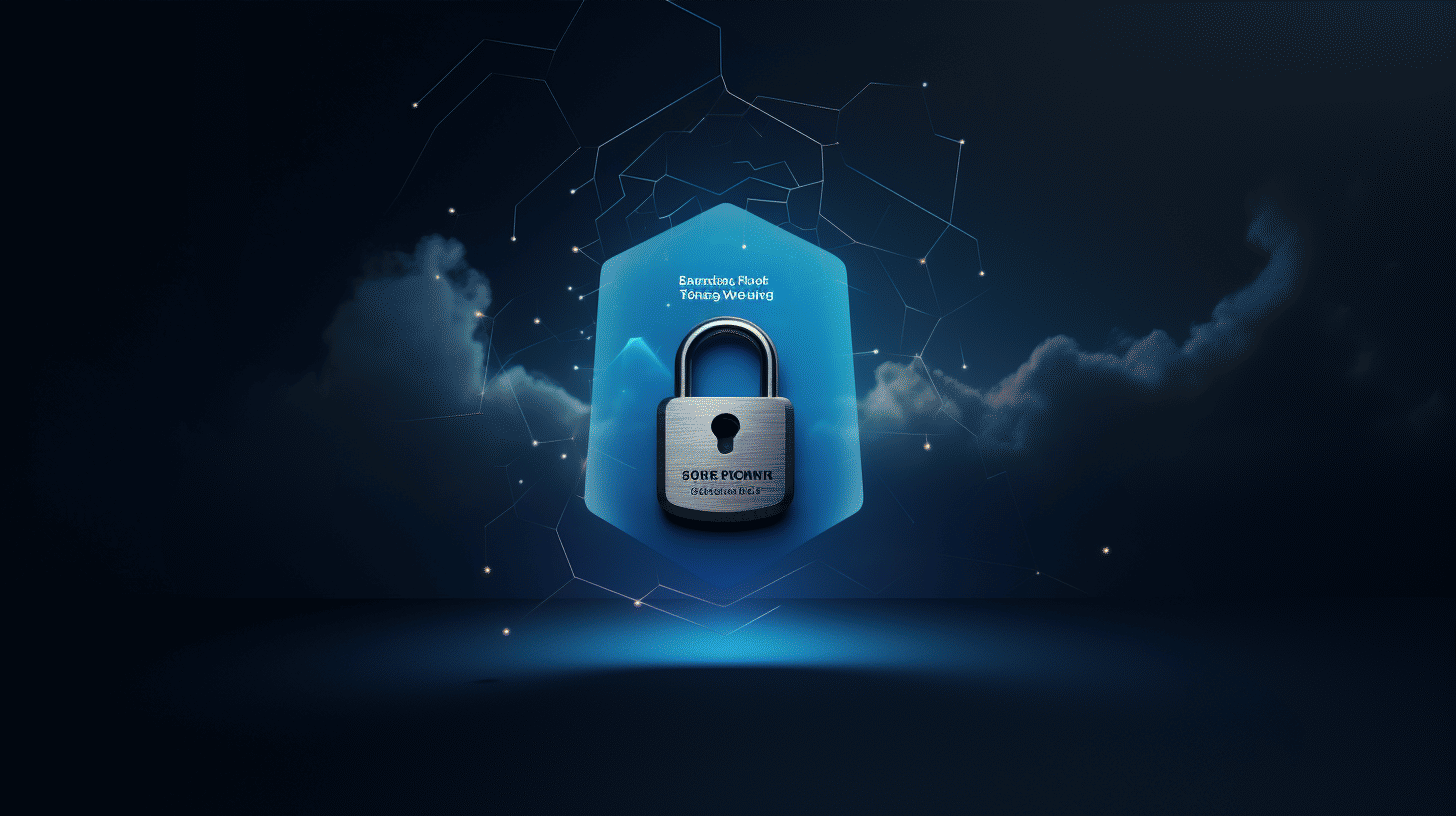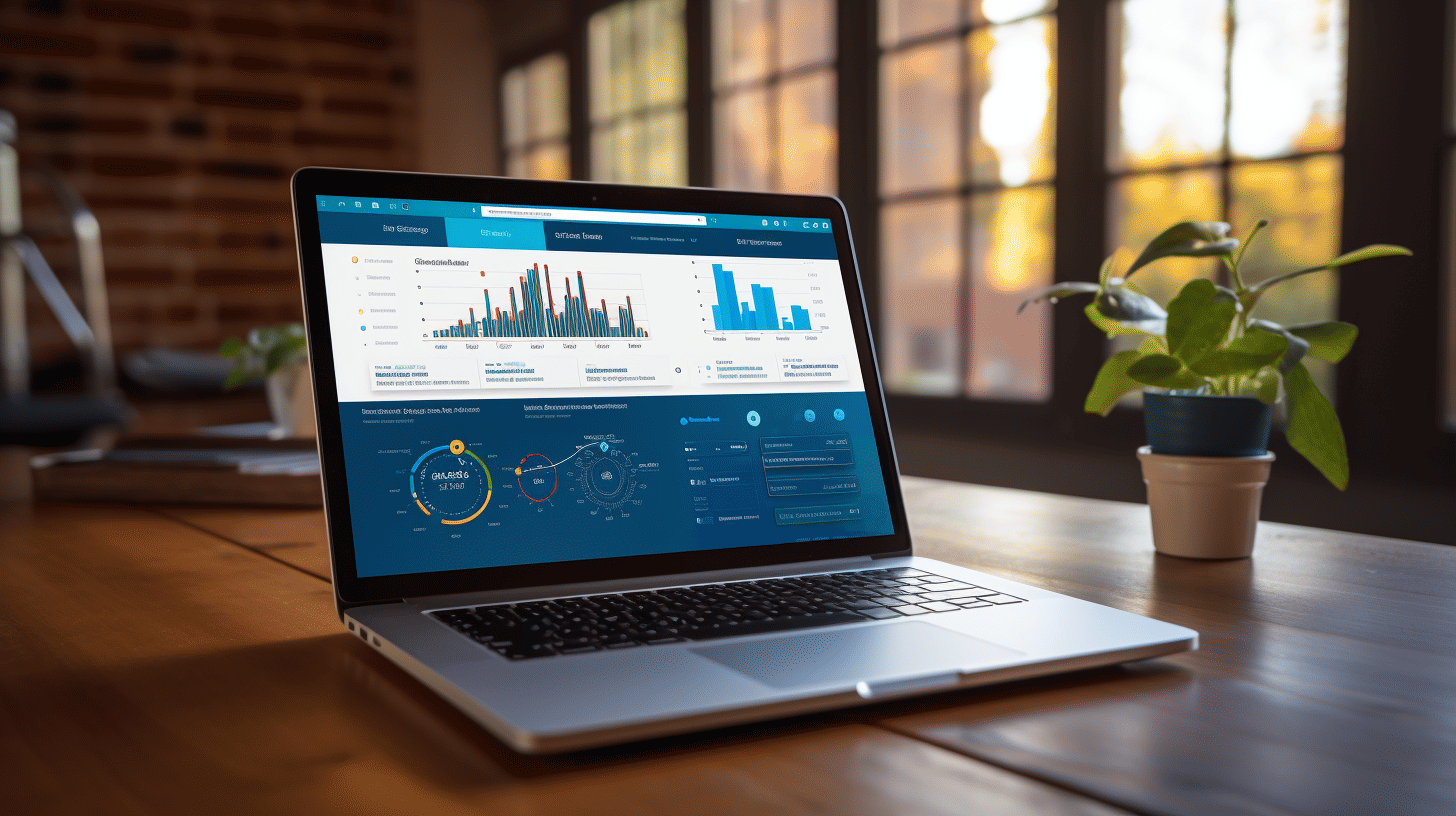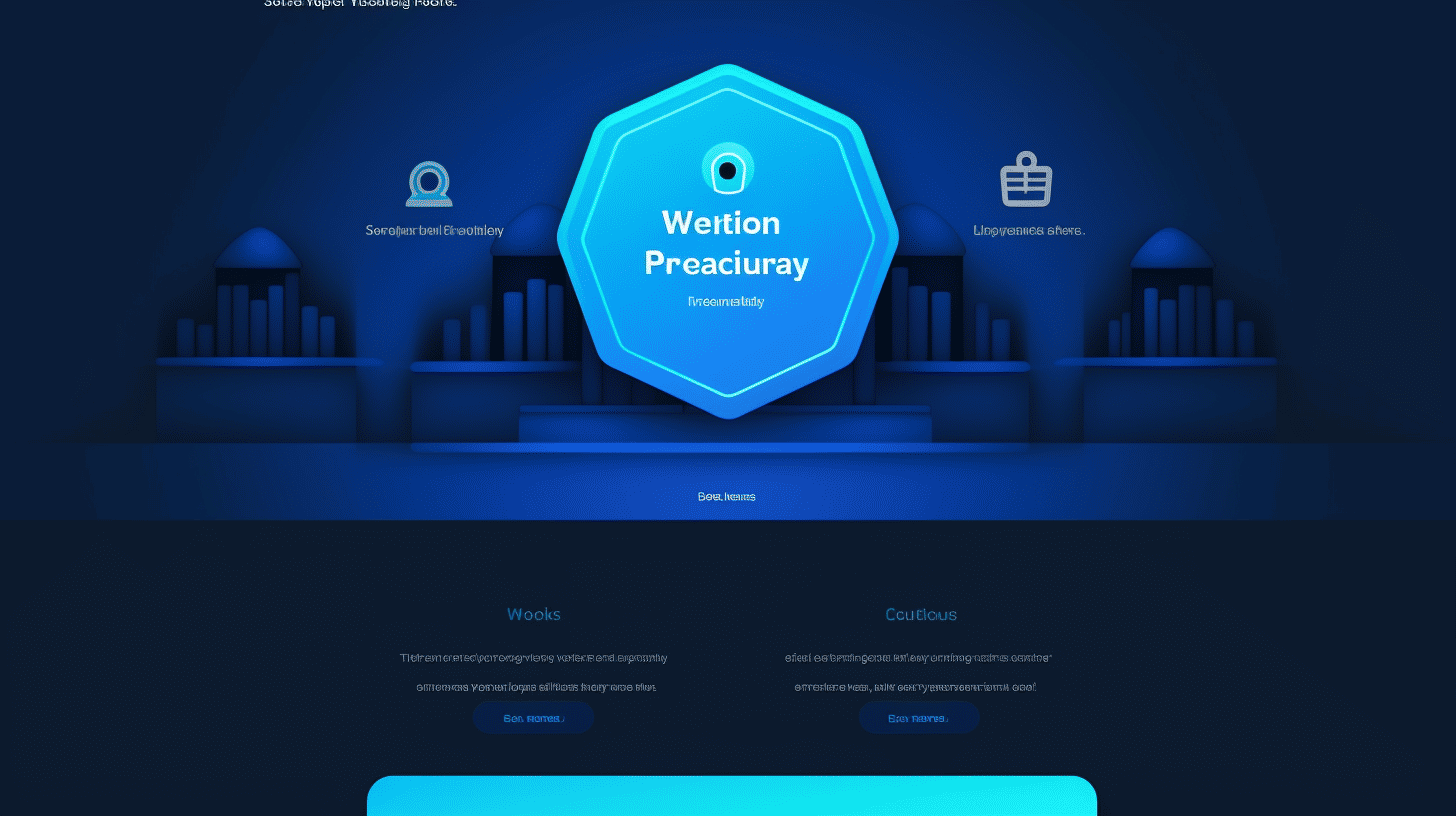在当今的数字时代,拥有强大的在线影响力对于小型企业至关重要。最受欢迎的网站构建平台之一是 WordPress。凭借其用户友好的界面和广泛的自定义选项,WordPress 已成为许多企业家的首选。然而,能力越大,责任越大。小型企业主必须了解保护其 WordPress 投资免受潜在安全威胁的重要性。
🔒🔐🚀
在本文中,我们将探讨保护 WordPress 网站安全并保护您宝贵数据的最佳做法。无论您是经验丰富的 WordPress 用户还是刚开始使用的新手,这些技巧都将帮助您加强网站抵御黑客、恶意软件和其他潜在安全风险的攻击。
因此,让我们深入研究并发现确保 WordPress 站点的安全性和使用寿命所需的关键步骤。从保持 WordPress 核心、主题和插件更新到实施双因素身份验证和保护管理区域,我们将涵盖所有内容。在本文结束时,您将掌握必要的知识和工具来保护您的 WordPress 投资并为您的小型企业提供应有的安全保障。🛡️💼
保持 WordPress 核心、主题和插件更新的重要性
在当今的数字环境中,拥有一个安全的网站至关重要。随着网络威胁和黑客攻击的不断增加,确保网站及其所保存数据的安全比以往任何时候都更加重要。保护您的 WordPress 网站的一种有效方法是定期更新其核心、主题和插件。
为什么更新很重要?
过时的软件可能会让您的网站容易受到黑客攻击。黑客一直在寻找 WordPress 等流行平台中的漏洞进行攻击。当开发人员发现并修复这些漏洞时,他们会发布更新来修补它们。通过保持 WordPress 核心、主题和插件的更新,您可以确保拥有最新的安全补丁并防范新兴威胁。
强调更新重要性的统计数据
根据最近的 WordPress 漏洞报告,大多数漏洞来自插件,而不是核心本身。事实上,报告指出 97% 的漏洞来自插件,2.4% 来自主题,只有 0.05% 来自核心。这凸显了插件在网站安全中发挥的重要作用,并进一步强调了保持插件更新的重要性。
另一个令人震惊的统计数据是,2023 年全球有超过 7500 万个 WordPress 网站遭到攻击。这个惊人的数字展示了针对 WordPress 网站的网络攻击的广泛性,并提醒我们采取主动措施保护您的网站的重要性。
更新 WordPress 核心、主题和插件的主要好处
定期更新 WordPress 核心、主题和插件可带来以下好处:
- 增强安全性:更新通常包括解决漏洞的重要安全补丁。通过保持更新,您可以降低网站被黑客入侵的风险。
- 提高性能:更新不仅可以解决安全问题,还可以增强网站的整体性能。它们可能包括错误修复、优化和新功能,可以改善网站的功能和速度。
- 兼容性:更新可确保与最新版本的 WordPress 和其他插件兼容。这有助于防止冲突并确保您的网站顺利运行。
- 访问新功能:更新通常会引入新特性和功能,从而增强您网站的用户体验。通过定期更新,您可以利用这些新功能并保持领先于竞争对手。
- 支持和维护:通过保持最新状态,您更有可能获得开发人员和 WordPress 社区的支持和帮助。旧版本的软件通常不再受支持,这使得解决问题变得困难。
结论
更新 WordPress 核心、主题和插件是维护网站安全性和功能的重要步骤。通过保持最新状态,您可以降低安全漏洞的风险、提高性能、确保兼容性并获得新功能的访问权限。因此,不要忽视这些更新通知 - 它们可能是确保网站安全且顺畅运行的关键。
阅读更多关于 WordPress 漏洞报告 了解有关保护 WordPress 网站安全的最新安全趋势和建议。
使用 SSL/TLS 证书保护用户数据
🔒 在当今的数字时代,确保用户数据的安全和隐私至关重要。随着在线威胁和网络攻击的数量不断增加,企业需要采取主动措施来保护敏感信息。其中一项措施是使用 SSL/TLS 证书。
🔐 SSL(安全套接字层)及其后继者 TLS(传输层安全性)是加密协议,为互联网上的数据通信提供加密和身份验证。通过使用 SSL/TLS 证书,企业可以在其网站和用户浏览器之间建立安全连接,建立信任并保护传输数据的机密性。
⭐ SSL/TLS 证书是强大安全策略的重要组成部分。以下是它们对于保护用户数据至关重要的一些原因:
1. 数据加密
🔐 当网站上安装了 SSL/TLS 证书后,它可以通过加密服务器和用户浏览器之间传输的数据来实现安全通信。这种加密确保即使数据被恶意行为者拦截,他们也无法理解和使用这些数据。
2. 网站认证
🔒 SSL/TLS 证书还可用作验证网站身份的一种手段。它们向用户保证他们正在与目标网站互动,而不是欺诈网站。这对于处理敏感信息(例如登录凭据、财务详细信息或个人信息)的网站尤其重要。
3. 信任与信心
🔑 通过在浏览器的地址栏中显示挂锁符号和 HTTPS 协议,SSL/TLS 证书可以给用户带来信任和信心。这表明该网站已采取措施保护用户的数据并提供安全的浏览体验。相比之下,没有 SSL/TLS 证书的网站可能会被现代浏览器标记为不安全,导致用户在分享任何信息之前犹豫不决。
4. 遵守数据保护法规
🔒 处理用户数据(尤其是个人身份信息 (PII))的企业需要遵守各种数据保护法规,例如《通用数据保护条例》(GDPR) 或《加州消费者隐私法案》(CCPA)。实施 SSL/TLS 证书通常是满足这些合规性要求和保护用户隐私的必要步骤。
5.提高搜索引擎排名
🚀 除了安全优势之外,SSL/TLS 证书还具有 SEO 优势。Google 等搜索引擎会优先考虑使用 HTTPS 的网站,而不是没有 HTTPS 的网站。因此,拥有 SSL/TLS 证书可以对网站的搜索引擎排名产生积极影响,让搜索相关关键字的用户更容易看到它。
🔒总之,SSL/TLS 证书在保护用户数据和建立在线信任方面发挥着至关重要的作用。通过加密数据、验证网站和提供安全的浏览体验,企业可以保护敏感信息并遵守数据保护法规。此外,凭借其提供的 SEO 优势,SSL/TLS 证书已成为维持强大在线形象的重要组成部分。
安全 WordPress 托管提供商的优势
在当今的数字环境中,网站安全至关重要。随着网络威胁变得越来越复杂和普遍,企业必须优先考虑确保其在线业务的安全。网站安全的一个重要方面是选择可靠且安全的 WordPress 托管提供商。在本节中,我们将探讨选择安全的 WordPress 托管提供商的好处以及他们如何保护您的网站免受潜在风险。
防火墙
安全的 WordPress 托管服务提供商的一大优势是实施了强大的防火墙。防火墙充当您的网站与潜在威胁之间的屏障,确保只有合法流量才允许通过。这些先进的安全措施可以帮助保护您的网站免受黑客、恶意软件和其他恶意活动的侵害。有了安全的 WordPress 托管服务提供商,您可以放心,因为您的网站受到强大的防火墙的保护,该防火墙会不断监控和过滤传入流量。
恶意软件扫描
安全的 WordPress 托管提供商的另一个主要优势是包含定期恶意软件扫描。恶意软件是指可能感染您的网站并危害其安全性的恶意软件,例如病毒或间谍软件。安全的 WordPress 托管提供商使用复杂的扫描工具来检测和消除您网站上的恶意软件。通过定期扫描恶意软件,这些提供商可确保您的网站保持干净和安全,从而最大限度地降低数据泄露或未经授权访问敏感信息的风险。
定期备份
意外总是会发生,有时网站可能会因为硬件故障、人为错误或网络攻击而丢失数据。这就是安全的 WordPress 托管提供商真正出彩的地方。他们通常会定期备份您的网站,确保您在紧急情况下拥有一份数据副本。有了这些备份,如果出现任何不可预见的问题,您可以快速将网站恢复到以前的状态。定期备份是一张宝贵的安全网,可以保护您的业务免受重大中断和潜在宝贵数据的丢失。
通过选择安全的 WordPress 托管服务提供商,您将受益于防火墙、恶意软件扫描和定期备份等高级安全措施。这些提供商优先考虑您网站的安全性,让您可以专注于经营业务,而不必担心潜在的网络威胁。凭借其专业知识和对保护您在线形象的承诺,安全的 WordPress 托管服务提供商是任何企业主的必不可少的投资。
要了解有关为您的企业选择合适的托管 WordPress 托管解决方案的更多信息,请查看我们的 安全的 WordPress 托管提供商文章.
强密码和限制登录尝试
在当今的数字环境中,保护我们的个人信息安全比以往任何时候都更加重要。保护我们的在线帐户最简单、最有效的方法之一是使用强密码并限制登录尝试次数。这不仅可以保护我们的敏感数据,还可以防止未经授权访问我们的帐户。让我们深入了解这些安全措施为何至关重要以及如何实施它们。
强密码的重要性
🔒 强密码可以有效防御黑客和网络犯罪分子,他们总是在寻找弱密码来利用。强密码就像一道几乎坚不可摧的屏障,保护着我们的个人和财务信息。以下是强密码至关重要的几个关键原因:
- 防止暴力攻击: 强密码使黑客更难通过暴力攻击来未经授权访问我们的帐户,他们会系统地尝试不同的组合,直到找到正确的密码。
- 降低与密码相关的风险: 弱密码(例如常用词、容易猜到的组合(例如“123456”)或个人信息)可能会使我们的帐户面临风险。包含大小写字母、数字和符号的强密码可大大降低未经授权访问的可能性。
- 防范凭证填充: 凭证填充是一种黑客利用从其他数据泄露中窃取的用户名和密码组合来未经授权访问其他帐户的技术。每个帐户都使用独特的强密码有助于防止凭证填充攻击得逞。
实施强密码
创建一个强密码乍一看似乎很困难,但这是值得付出努力的。以下是一些提示,可帮助您想出一个既强大又容易记住的密码:
- 使用大写和小写字母、数字和符号的组合。
- 避免使用容易猜到的信息,例如您的姓名、出生日期或最喜欢的运动队。
- 选择较长的密码,因为它们通常更安全。
- 考虑使用密码短语而不是单个单词,将几个容易记住但别人难以猜到的单词组合在一起。
请记住,密码强度对帐户安全有重大影响。花点时间为每个在线帐户创建独特且强度高的密码,以最大程度地防止未经授权的访问。
限制登录尝试
🛡️ 限制登录尝试次数是增强帐户安全性和阻止未经授权访问的另一种有效方法。通过设置登录尝试失败次数的限制,我们可以防止潜在攻击者尝试无数种组合,直到找到正确的密码。这就是为什么这个简单的措施如此有效:
- 阻止暴力攻击: 通过限制登录尝试次数,我们让黑客通过暴力攻击破解密码的难度大大增加。在一定次数的登录尝试失败后,帐户将被锁定或暂时禁用,让恶意行为者很难获得访问权限。
- 防止自动攻击: 许多黑客攻击都是通过自动软件进行的,这些软件会快速尝试不同的密码组合。限制登录尝试次数可以有效地抵御这些自动攻击,方法是在尝试失败次数达到预定次数后阻止访问。
- 提醒我们注意可疑活动: 如果我们收到多次登录失败的通知,则表明存在潜在的未经授权的访问尝试,这可以作为预警信号。这使我们能够立即采取行动,例如更改密码和加强安全措施。
实施登录尝试限制可能因所使用的平台或服务而异。一些常见策略包括:
- 设置暂时锁定之前的最大登录尝试次数。
- 在连续登录尝试之间实施延迟,以减缓暴力攻击。
- 利用多因素身份验证来增加额外的安全层。
通过限制登录尝试次数,我们大大降低了成功进行暴力攻击和未经授权访问我们帐户的风险。
🔑 总之,强密码和限制登录尝试是强大的在线安全策略的重要组成部分。通过采取这些措施,我们可以更好地保护我们的个人信息、财务资源和在线身份免受网络威胁。请记住,花一点时间和精力创建强密码可以大大保护您的帐户安全。通过实施这些简单而有效的安全措施,领先黑客一步!
定期扫描网站以查找恶意软件和安全问题
🔒 保护您的网站:定期扫描的重要性
在当今的数字环境中,网站安全至关重要。网络威胁不断增加,各种规模的在线企业都面临着成为恶意软件攻击受害者的风险。但不要害怕!通过实施定期的网站扫描实践,您可以加强您的在线形象并阻止恶意行为者。
🔍 什么是网站扫描?
网站扫描包括系统地检查您的网站是否存在任何漏洞或恶意软件迹象。这是一种主动保护在线平台的方法,通过及时识别和解决安全问题来保护您的在线平台。通过定期扫描,您可以领先一步防范潜在威胁,并采取适当的措施来保护您的网站及其访问者。
🛡️ 定期网站扫描的好处
定期网站扫描不仅能保护您的在线形象,还能带来诸多好处。以下是您应该优先考虑的几个原因:
- 检测并消除恶意软件:扫描可以发现隐藏的恶意软件、恶意代码注入或可能损害您网站完整性的可疑文件。通过识别这些威胁,您可以快速删除它们并防止对您的网站及其访问者造成任何损害。
- 保护用户数据:您的网站可能会收集用户的敏感信息,例如个人数据或付款详细信息。定期扫描可确保这些数据保持安全,从而降低未经授权访问或数据泄露的风险。
- 维护搜索引擎声誉:Google 等搜索引擎会优先考虑安全的网站,并给予它们更高的搜索排名。通过定期扫描您的网站,您可以展示您对安全性的承诺,提高您的 SEO 性能,并吸引更多自然流量。
- 增强用户信任:随着网络安全问题的日益严重,用户在浏览网页时也变得更加谨慎。通过定期扫描来表明您重视网站安全,您可以让访问者放心,并建立对您品牌的信任。
- 保持合规:根据您所在的行业,您可能需要遵守某些安全法规和标准。定期扫描网站可帮助您确保遵守这些要求,避免潜在的处罚和声誉损害。
🔧 实施定期网站扫描
要充分利用定期网站扫描,请按照以下步骤操作:
- 选择可靠的网站安全解决方案:选择提供全面扫描功能的知名网站安全工具。寻找恶意软件检测、漏洞评估和实时监控等功能。
- 安排自动扫描:设置定期扫描计划,确保持续监控您的网站。这将帮助您及时发现任何安全问题并防止潜在风险升级。
- 查看扫描结果:扫描完成后,请仔细检查结果以识别任何漏洞或恶意软件检测。立即采取行动解决这些问题,以维护安全的环境。
- 保持更新:使用最新的安全补丁和更新来更新您的网站和所有相关软件。定期检查新威胁和漏洞,以防范新出现的风险。
💡 结论
在日益互联的世界里,网站安全应成为所有企业的首要任务。定期网站扫描是保护您的在线平台、用户数据和品牌声誉的关键步骤。通过实施正确的安全措施并进行例行扫描,您可以增强您的数字存在感并领先一步应对网络威胁。不要让恶意软件和安全问题危及您的业务 - 立即开始扫描!
启用双因素身份验证 (2FA) 以增强安全性
在当今的数字环境中,个人信息和在线账户被泄露的风险越来越大,采取主动措施保护自己至关重要。其中一项措施就是启用双因素身份验证 (2FA)。🛡️✨
什么是双因素身份验证 (2FA)?
双重身份验证(也称为 2FA)是一种额外的安全措施,有助于保护您的在线帐户。它为登录过程增加了一个额外的步骤,确保即使有人掌握了您的密码,他们也无法在没有第二重身份验证的情况下访问您的帐户。📲🔒
双重身份验证如何工作?
启用 2FA 后,登录过程将变为两步验证过程。让我们仔细看看它的工作原理:
- 步骤 1:密码:您照常输入用户名和密码。
- 第 2 步:第二重验证:成功输入密码后,系统会提示您提供第二种验证方式。这可以是通过短信发送到您的移动设备的唯一代码、身份验证器应用程序生成的代码,甚至是指纹或面部识别等生物特征数据。
通过要求使用多种因素进行身份验证,2FA 提供了额外的安全保障,降低了未经授权访问您的帐户的风险。💪🔐
启用双因素身份验证的好处
启用 2FA 有很多好处,包括:
- 增强安全性:使用 2FA 后,即使有人设法获取您的密码,他们也无法在没有第二重身份验证的情况下登录。这增加了一层额外的保护,防止未经授权的访问。
- 跨多设备保护:2FA 可以设置为在各种设备上工作,例如您的手机、平板电脑或计算机。这可确保您的帐户保持安全,无论您使用哪种设备访问它们。
- 防御网络钓鱼攻击:网络钓鱼攻击是指攻击者诱骗您在虚假网站上提供登录凭据,这种攻击可以通过 2FA 来阻止。即使攻击者通过网络钓鱼尝试获取您的密码,他们也无法通过第二个因素来访问您的帐户。
- 安心:启用 2FA 可让您高枕无忧,因为您的帐户将获得额外的安全保护。您可以放心,因为您的敏感信息将得到更好的保护。
如何为您的帐户启用双因素身份验证
启用 2FA 的过程可能因您使用的平台或服务而异。但是,启用 2FA 的一般步骤如下:
- 步骤 1:找到安全设置:转到您要保护的平台或服务的安全设置。查找与双重身份验证或帐户安全相关的选项。
- 第 2 步:选择第二个因素:选择您喜欢的第二个身份验证因素。这可以是通过短信接收代码、使用身份验证器应用程序,甚至是生物特征身份验证。
- 步骤 3:按照设置流程操作:按照屏幕上的说明设置第二重身份验证。这可能涉及链接您的手机号码、扫描二维码或配置您的设置。
请记住保存备用代码,以防您无法访问主要身份验证因素。这些备用代码可用于在必要时访问您的帐户,因此请将其保存在安全的地方。
结论
启用双重身份验证 (2FA) 可为您的在线帐户增加一层额外的安全保护,并有助于保护您的敏感信息免遭未经授权的访问。通过要求多种形式的验证,2FA 可提供增强的安全性和安心。花点时间为您的帐户启用 2FA,立即加强您的数字防御!🔒✨
WordPress 网站的定期备份
保护您的网站:定期备份的重要性
想象一下:你花了无数个小时创建和完善你的 WordPress 网站。这是你的骄傲和喜悦,你的在线杰作。但如果有一天,灾难降临了怎么办?你的网站被黑客入侵,或者你不小心删除了重要文件。你所有的辛苦工作,瞬间化为乌有。😱
这就是定期备份的作用所在。备份您的 WordPress 网站就像为您的在线形象投保一样。它可以确保在发生灾难时,您可以轻松地将网站恢复到以前的辉煌。在本节中,我们将探讨定期备份的重要性以及为什么您应该将其作为优先事项。
忽视备份的后果
🌪️如果没有定期备份,你的 WordPress 网站很容易受到各种风险的攻击:
- 数据丢失:如果您的网站的文件或数据库损坏或被意外删除,您可能会丢失宝贵的内容、客户信息或重要设置。
- 安全漏洞:黑客总是在四处寻找网站漏洞。如果没有备份,从受感染的网站恢复将非常困难。
- 插件或主题冲突:有时,错误的插件或主题更新可能会破坏您的网站。如果没有备份,恢复到正常工作的版本会变得更加困难。
定期备份的好处
✅ 定期备份你的 WordPress 网站有几个好处:
- 安心:知道您有最近的备份可以依靠,这可以减轻潜在灾难的压力。
- 轻松恢复:通过备份,您可以快速将您的网站恢复到以前的状态或恢复丢失的特定文件或数据。
- 节省时间和成本:如果没有备份,您可能需要花费大量时间和资源从头开始重建网站。定期备份可为您免去这一负担。
WordPress 备份的最佳实践
🔒为确保您得到充分保护,请遵循以下 WordPress 备份最佳做法:
- 自动化流程:安排定期自动备份,这样您就不必依赖很容易被忘记的手动备份。
- 异地存储备份:将备份保存在安全的异地位置,与 WordPress 托管服务器分开。这样,即使服务器崩溃,您仍然可以访问备份。
- 测试您的备份:定期测试恢复过程以确保您的备份正常运行。最好在陷入危机之前发现备份存在任何问题。
- 考虑使用具有备份服务的插件或 Web 主机:有许多插件和网络主机提供专门针对 WordPress 站点的备份服务。探索这些选项以简化备份过程。
结论
🔑 不要等到为时已晚才保护您的 WordPress 网站。定期备份对于保护您的辛勤工作和确保您的在线状态保持完整至关重要。通过实施备份策略并遵循最佳实践,您可以高枕无忧,因为如果发生意外,您将准备好快速恢复并比以往更加强大。
使用插件保护 WordPress
🔒 在当今的数字环境中,确保 WordPress 网站的安全至关重要。随着网络威胁日益普遍,采取主动措施保护您的网站免受潜在黑客和攻击者的攻击至关重要。加强 WordPress 网站的一种有效方法是使用安全插件。这些插件提供了一系列功能,旨在增强您网站的安全性并保护其免受恶意活动的侵害。在本文中,我们将探讨两个流行的 WordPress 安全插件:Wordfence 和 Sucuri。
Wordfence
说到 WordPress 安全插件,Wordfence 无疑是最受信任和使用最广泛的选项之一。Wordfence 拥有超过 400 万个活跃安装,提供了一套全面的安全工具来保护您的 WordPress 网站。以下是 Wordfence 的一些主要功能:
- Web 应用程序防火墙 (WAF): Wordfence 拥有强大的 WAF,可主动监控和过滤传入流量以识别和阻止恶意活动。它分析网站流量模式并识别潜在威胁,提供针对黑客、机器人和其他恶意实体的实时保护。
- 恶意软件扫描: Wordfence 会定期扫描您的 WordPress 网站,以检测任何恶意软件或可疑文件。它会检查核心文件、主题和插件,确保您的网站没有潜在的安全漏洞。
- 登录安全: 使用 Wordfence,您可以实施强大的登录安全措施,例如双因素身份验证 (2FA) 和强密码强制执行。这些功能增加了一层额外的保护,以防止未经授权访问您的 WordPress 管理区域。
苏库里
另一个备受推崇的 WordPress 安全插件是 Sucuri。Sucuri 专注于网站安全,提供针对各种在线威胁的全面保护。以下是 Sucuri 的一些显著特点:
- 网站防火墙: Sucuri 的网站防火墙 (WAF) 可充当您的 WordPress 网站与潜在攻击者之间的屏障。它拦截并过滤恶意请求,确保只有合法流量到达您的网站。这有助于防止黑客攻击和暴力攻击。
- 恶意软件清理: 如果您的 WordPress 网站不幸感染了恶意软件,Sucuri 可以帮助您清理。他们的安全专家团队将扫描您的网站,删除所有恶意软件,并将其恢复到干净安全的状态。
- 安全通知: Sucuri 会向您发送有关 WordPress 网站潜在威胁的实时安全通知,让您随时了解最新情况。这样您就可以立即采取行动,及时解决任何安全问题。
Wordfence 和 Sucuri 都提供了出色的安全功能,但值得一提的是,同时使用多个安全插件可能会出现兼容性问题并影响网站的性能。建议选择一个符合您特定安全需求的插件并坚持使用它。
🔐 实施强大的安全插件是保护您的 WordPress 网站免受潜在威胁的主动步骤。通过使用 Wordfence 或 Sucuri 等插件,您可以增强网站的整体安全性、保护敏感数据并为访问者提供安全的浏览体验。不要让您的 WordPress 网站的安全性处于危险之中 - 立即采取行动!
实施防火墙保护
在我们生活的快节奏数字世界中,网络安全至关重要。随着网络威胁的增加,保护您的在线资产已成为必需。您的网络安全武器库中一个必不可少的工具就是防火墙。
防火墙是计算机网络与外界之间的一道屏障,用于监控和控制传入和传出的网络流量。它有助于阻止不需要的和可能有害的流量进入您的系统,同时允许安全合法的流量通过。
以下是实施防火墙保护的一些主要好处:
1.网络安全
防火墙是防止未经授权访问您的网络的第一道防线。通过过滤传入流量,防火墙可以防止恶意黑客进入您的系统并泄露敏感数据。它们还可以阻止流向可疑或列入黑名单的目的地的出站流量,从而防止潜在的数据泄露。
2.入侵防御
防火墙可以检测并阻止未经授权的访问尝试,例如端口扫描和暴力攻击。它们分析网络流量模式并将其与预定义的安全规则进行比较,以识别可疑活动。如果检测到入侵尝试,防火墙可以立即采取行动,阻止源 IP 地址或向网络管理员发出警报。
3. 应用程序控制
防火墙还可以对可以访问您网络的应用程序提供精细控制。通过设置基于应用程序的规则,您可以决定哪些软件可以与外界通信。这有助于防止恶意软件传播并限制潜在的安全漏洞。
4.内容过滤
防火墙可用于执行内容过滤策略,阻止访问特定网站或特定类型的内容。这在公司环境中尤其有用,可以防止员工访问可能带来安全风险或分散其工作职责的网站。
5.安全远程访问
如果您的企业允许远程访问内部资源,防火墙在保护这些连接方面可以发挥关键作用。通过实施虚拟专用网络 (VPN) 技术,防火墙可以为远程用户创建安全隧道,以访问您的网络资源,同时确保他们的通信加密并受到保护。
实施防火墙保护解决方案是保护您的网络和敏感数据免受网络威胁的重要一步。要了解如何有效实施防火墙保护的更多信息,请查看此 综合指南 防火墙实施和最佳实践。注意安全!🔒
删除未使用的主题和插件
📸 捕捉您网站的精髓:删除未使用的主题和插件!
在管理网站时,有时少即是多。随着网站的发展,您可能会发现自己积累了大量不再有用的主题和插件。这些未使用的资源会使您的网站变得混乱,降低其性能,甚至带来安全风险。现在是时候通过删除这些未使用的主题和插件来清理和优化您的网站了!
为什么要删除未使用的主题和插件?
- 提高网站性能: 您网站上的每个主题和插件都会增加一些开销,影响网站的速度和整体性能。删除未使用的主题和插件可以减轻这种负担,从而缩短访问者的加载时间。
- 增强的安全性: 未使用的主题和插件是黑客和恶意行为者的潜在入口点。通过卸载它们,您可以减少攻击面并最大限度地降低网站被入侵的风险。
- 简化的网站管理: 需要更新的主题和插件更少,您将获得更简化的管理体验。您可以将精力集中在推动网站成功的关键要素上。
- 增强稳定性: 插件和主题会相互影响,并会与您网站的核心文件产生影响。它们之间的不兼容性可能会导致错误、崩溃,甚至死机白屏。通过消除未使用的资源,您可以最大限度地减少兼容性问题的可能性,并创建更稳定的网站环境。
如何删除未使用的主题和插件
- 🏗️ 评估您的网站: 首先,对当前的主题和插件进行全面盘点。确定哪些不再使用或需要。注意它们提供的任何特定功能,并确定是否有合适的替代品或内置功能可以替代它们。
- 🧹 停用并删除: 确定未使用的主题和插件后,就该停用它们并将其从您的网站中删除。具体操作如下:
- 主题: 导航到您的 WordPress 仪表板,转到“外观”→“主题”。将鼠标悬停在要删除的主题上,然后单击“主题详细信息”按钮。在右下角,您会找到“删除”选项。确认删除,主题将从您的网站中永久删除。
- 插件: 从 WordPress 仪表板,转到“插件”→“已安装的插件”。找到要删除的插件,然后单击其名称下方的“停用”链接。停用后,将出现“删除”选项。单击它将从您的网站中删除该插件。
- 🧪 测试您的网站: 删除未使用的主题和插件后,测试您的网站是否存在任何意外问题或错误至关重要。确保网站的布局、功能和性能保持完好。
保持网站整洁、繁荣
通过删除未使用的主题和插件,您不仅可以优化网站的性能,还可以增强其安全性并简化管理任务。告别不必要的臃肿,迎接精简高效的网站。今天就开始清理杂乱,让您的网站焕发活力!请记住,整洁的网站才是蓬勃发展的网站。🌟
定期更新以修补安全漏洞
在当今的数字环境中,网络威胁不断演变,积极主动地保护您的系统和数据免受恶意行为者的攻击至关重要。最有效的方法之一是定期更新您的软件和操作系统以修补安全漏洞。
通过保持最新更新,您可以确保您的系统能够抵御最新的威胁和入侵。以下是定期更新以修补安全漏洞应成为首要任务的几个令人信服的理由:
- 保持领先一步: 网络犯罪分子一直在寻找软件和操作系统中的漏洞进行利用。通过定期更新,您可以领先一步,在攻击者利用之前关闭潜在的入口点。
- 防范已知漏洞: 软件供应商和安全研究人员不断发现和解决安全漏洞。更新通常与专门用于修复这些漏洞的补丁捆绑在一起,以防止潜在的攻击。
- 增强系统性能: 更新不仅能解决安全问题,而且通常还包括性能增强和错误修复。通过定期更新,您可以确保系统平稳高效地运行。
- 保持合规性: 许多行业法规(例如 PCI DSS 或 GDPR)都要求组织使用最新的安全补丁来更新其系统。通过定期更新,您可以继续遵守这些标准并避免潜在的罚款或其他处罚。
为了使更新过程更顺畅、更少中断,请考虑以下提示:
- 自动更新: 尽可能启用自动更新,以确保您的软件和操作系统不断得到修补,而无需不断的人工干预。
- 确定关键系统的优先级: 识别并优先考虑存储敏感数据或与互联网直接连接的关键系统或应用程序。首先重点关注保持这些系统的更新,以最大限度地降低风险。
- 测试更新: 在整个组织范围内推出软件更新之前,在受控环境中测试它们至关重要。这有助于识别任何可能影响系统稳定性的兼容性问题或意外问题。
- 教育用户: 提高员工对定期更新软件和操作系统重要性的认识。鼓励他们及时在个人设备上安装更新,以最大限度地降低潜在的安全风险。
请记住,定期更新以修补安全漏洞是一个持续的过程。网络威胁不断演变,软件供应商不断发布新补丁来解决新出现的漏洞。通过保持警惕和主动性,您可以显著降低成为网络攻击受害者的风险,并确保系统和数据的安全。
⚠️ 请记得定期备份您的数据,以防止在更新过程中出现意外问题而造成任何损失。
具有唯一访问凭证的管理区域安全性
🔒 简介:保护网站的管理区域对于确保系统的整体安全至关重要。增强此安全性的一种有效方法是实施管理区域的唯一访问凭据。通过要求管理员拥有不同的登录凭据,您可以显著降低未经授权的访问和潜在安全漏洞的风险。
唯一访问凭证的重要性
拥有管理区域的唯一访问凭据有几个好处,包括:
- 🛡️ 增强安全性:通过为每个管理员设置唯一的用户名和密码,您可以为管理区域添加额外的保护层。这使得入侵者更难获得未经授权的访问,从而降低数据泄露和恶意活动的风险。
- 🗝️ 责任制:当每个管理员都有自己的一组凭据时,跟踪和识别用户操作变得更加容易。 如果发生任何可疑活动,更容易确定责任方并采取适当的措施。
- 💪 细粒度权限:使用唯一访问凭证,您可以为每个管理员分配特定权限和特权。这样您就可以控制对敏感区域的访问,并将某些操作限制为仅授权人员。
实施唯一访问凭证
为了确保唯一访问凭证的有效性,请考虑以下最佳做法:
- 📝 使用强密码:鼓励管理员创建包含数字、字母(大写和小写)和特殊字符组合的复杂密码。避免使用常用词或容易猜到的信息,如生日或宠物名。
- 👥 启用多因素身份验证:实施多因素身份验证可增加一层额外的安全性,因为除了密码外,管理员还需要提供其他验证,例如发送到其移动设备的唯一代码。这大大降低了未经授权访问的风险。
- 🔒 定期更新凭证:定期更新访问凭证至关重要,以降低因密码泄露而导致未经授权访问的可能性。设置策略以强制定期更改密码并提前通知管理员。
结论
使用唯一访问凭证保护管理区域是保护网站或系统的基本步骤。通过实施这一额外的安全层,您可以保护宝贵的数据、确保责任制并保持对系统权限的精细控制。在设置和管理访问凭证时,请务必遵循最佳实践,以最大限度地发挥其有效性。
将 wp-config.php 移出根文件夹以增加保护
🔐 在保护你的 WordPress 网站时,你需要注意的一个关键文件是 wp-config.php。此文件包含敏感信息,例如您的数据库凭据、身份验证密钥和其他重要配置设置。如果黑客获得此文件的访问权限,他们可能会对您的网站造成严重破坏。
🛡️ 幸运的是,你可以采取一个简单但有效的步骤来增强你的 wp-config.php 文件:将其移出根文件夹。这样一来,未经授权的用户就更难找到和访问这个关键文件。
📂 但移动 wp-config.php 如何在根文件夹之外放置文件?该怎么做?让我们深入了解细节:
为什么要搬家 wp-config.php 在根文件夹之外?
🔒 WordPress 安装的根文件夹通常是存储网站主文件和文件夹的位置。默认情况下, wp-config.php 文件位于此位置。不幸的是,如果黑客知道文件存储的位置,他们可以轻松对其进行未经授权的访问。
💡 搬家 wp-config.php 根文件夹之外的文件会为您的 WordPress 网站增加一层额外的保护。当文件被放置在非公开可访问的目录中时,攻击者找到并利用它就会变得更加困难。
如何移动 wp-config.php 根文件夹之外
⚙️ 移动 wp-config.php 文件涉及几个简单的步骤。以下是帮助您完成该过程的分步指南:
- 备份您的
wp-config.phpfile: 在进行任何更改之前,最好先备份您的wp-config.php文件。这可确保您拥有原始文件的副本,以防出现任何问题。 - 创建新目录: 在 WordPress 安装的根文件夹之外创建一个新目录。考虑给它起一个不容易猜到的独特名称。
- 移动
wp-config.phpfile: 使用文件管理器或 FTP 客户端,将wp-config.php文件从根文件夹复制到刚刚创建的新目录。 - 更新 WordPress 安装中的文件路径: 现在你已经移动了
wp-config.php文件,您需要更新 WordPress 安装中的文件路径。打开索引.php在 WordPress 安装的根文件夹中创建一个文件,并在顶部添加以下代码行:
需要(目录名(__FILE__)。'/new-directory-name/wp-config.php');
代替 新目录名称 替换为您在步骤 2 中创建的目录的名称。
- 验证更改: 要确认一切正常,请访问您的网站并确保其正常运行。如果出现任何问题,您只需恢复备份即可恢复更改
wp-config.php文件。
🔑 通过遵循以下步骤,您可以有效地移动 wp-config.php 文件位于根文件夹之外,为您的 WordPress 网站提供额外的安全保障。
🚨 请记住采取其他安全措施,例如使用强密码、保持 WordPress 及其插件/主题为最新版本,以及定期备份您的网站以进一步保护您的在线状态。
实现 HTTP 身份验证
🔒 使用 HTTP 身份验证保护您的 Web 应用程序
在当今的数字时代,确保 Web 应用程序的安全比以往任何时候都更加重要。保护敏感信息的一种非常有效的方法是实施 HTTP 身份验证。通过要求用户在访问您的网站或其中的某些区域之前提供有效的凭据,HTTP 身份验证有助于保护您的数据免遭未经授权的访问。
🔐 HTTP 身份验证的主要优点
实施 HTTP 身份验证可为网站所有者和用户带来一系列好处。让我们来看看一些显著的优势:
- 增强的安全性: HTTP 身份验证为您的 Web 应用程序增加了额外的安全层。通过要求用户进行身份验证,您可以有效地防止未经授权访问敏感数据和资源。
- 简化的用户管理: 使用 HTTP 身份验证,管理用户访问变得简单得多。您可以利用 HTTP 协议的内置身份验证功能,而不必依赖复杂的用户管理系统。
- 灵活性: HTTP 身份验证允许您从不同的身份验证方法中进行选择,例如基本身份验证、摘要身份验证,甚至是自定义身份验证方案。这种灵活性使您能够根据自己的特定需求和要求定制身份验证过程。
- 与现有系统集成: HTTP 身份验证可与现有系统无缝集成,从而更轻松地将其整合到您的 Web 应用程序中。无论您使用的是内容管理系统 (CMS) 还是定制网站,实施 HTTP 身份验证通常都是一个简单的过程。
🗝️ 如何实现 HTTP 身份验证
实施 HTTP 身份验证是一个相对简单的过程。以下是帮助您入门的分步指南:
- 选择身份验证方法: 确定哪种身份验证方法最适合您的 Web 应用程序。基本身份验证方法是最容易实现的,但摘要和自定义方法可提供增强的安全性。
- 配置服务器: 配置您的 Web 服务器以启用 HTTP 身份验证。具体步骤将根据您使用的服务器软件(例如 Apache、NGINX)而有所不同。请参阅服务器的文档以获取详细说明。
- 创建用户凭证: 生成用于身份验证的必要用户凭证(例如用户名和密码)。执行强密码策略对于确保身份验证过程的完整性至关重要。
- 设置访问控制: 定义 Web 应用程序中需要身份验证的区域。这可以通过根据您的服务器配置将访问控制规则应用于特定目录、文件或 URL 来实现。
⚠️ 牢记安全最佳实践
虽然 HTTP 身份验证提供了额外的安全层,但请务必记住,它并不是万无一失的解决方案。为确保最高级别的安全性,请考虑以下最佳做法:
- 定期更新用户凭证并鼓励用户也这样做。
- 实施强密码策略,包括最小长度要求、复杂性规则和密码过期时间。
- 监控并记录身份验证尝试以检测潜在的攻击。
- 使用 HTTPS 等安全通信协议来防止窃听和数据篡改。
🔒 使用 HTTP 身份验证确保安全
通过实施 HTTP 身份验证,您可以显著增强 Web 应用程序的安全性,并保护您的敏感信息免遭未经授权的访问。花点时间了解可用的不同身份验证方法,并遵循上述最佳实践,以确保实施最强大的安全措施。您的用户会喜欢增加的保护层,而您可以放心,因为您的 Web 应用程序是安全的。
扫描 SQL 注入漏洞
在当今的数字环境中,网络安全至关重要。多年来造成重大损失的一个特殊漏洞是 SQL 注入。这种技术允许黑客利用 Web 应用程序中的弱点并获得对敏感数据的未经授权的访问。为了降低这种风险,组织必须主动扫描其系统中的 SQL 注入漏洞。在本文中,我们将深入研究扫描 SQL 注入漏洞的过程,并讨论这种做法在维护安全的数字环境中的重要性。
为什么要扫描 SQL 注入漏洞?
SQL 注入攻击可能会对企业和个人造成严重后果。通过利用 Web 应用程序中的漏洞,攻击者可以操纵 SQL 查询并获取敏感信息的访问权限、修改或删除数据,甚至控制整个系统。成功的 SQL 注入攻击的潜在后果包括:
- 泄露敏感客户数据,包括个人信息和财务信息
- 业务运营中断,导致财务损失和声誉受损
- 法律和监管后果,例如不遵守数据保护法
- 损害客户信任并失去商业机会
鉴于 SQL 注入攻击可能造成的潜在危害,组织必须采取主动措施识别和纠正漏洞,以免漏洞被利用。扫描 SQL 注入漏洞是此过程的重要组成部分。
如何扫描 SQL 注入漏洞
扫描 SQL 注入漏洞的过程涉及一种系统化的方法来识别潜在的弱点,并在它们被利用之前解决它们。以下是进行 SQL 注入漏洞扫描时要遵循的一些步骤:
- 评估应用前景: 了解组织内正在使用的 Web 应用程序和数据库。确定关键系统并确定扫描的优先级。
- 使用Web应用程序漏洞扫描程序: 利用专门设计用于扫描 Web 应用程序漏洞(包括 SQL 注入)的工具。这些扫描器会模拟攻击以识别潜在漏洞并提供补救建议。
- 执行手动代码审查: 除了使用自动扫描工具外,对代码库进行手动审查也是必不可少的。这涉及分析应用程序的源代码是否存在与 SQL 注入相关的潜在安全漏洞。
- 实施安全最佳实践: 确保在开发 Web 应用程序时遵循安全编码实践。实施输入验证、参数化查询和行业标准建议的其他安全措施。
- 定期更新和修补系统: 使用最新的安全补丁确保 Web 应用程序、数据库和支持基础设施保持最新状态。定期监控安全更新并及时应用它们以缓解已知漏洞。
通过认真遵循这些步骤并定期扫描 SQL 注入漏洞,组织可以显著降低成为恶意攻击受害者的风险。
总之,扫描 SQL 注入漏洞是维护安全数字环境的关键部分。通过主动识别和解决这些漏洞,组织可以保护自己和客户免受成功的 SQL 注入攻击可能造成的破坏性后果。保持警惕,实施安全最佳实践,并定期扫描您的系统,以确保对这种普遍存在的网络安全威胁进行强有力的防御。
使用的表情符号:🔐(代表安全)、💻(代表数字环境)、🚫(代表风险缓解)、💡(代表主动措施)、🎯(代表扫描)、💪(代表保护)、🛡️(代表防御)、🌟(代表最佳实践)
使用 Web 应用程序防火墙 (WAF) 进行保护
在当今的数字环境中,网络攻击的威胁无处不在。网站和 Web 应用程序是企业的宝贵资产,因此成为恶意行为者利用漏洞的主要目标。为了确保这些数字平台的安全性和完整性,组织需要采取强有力的保护措施。在保护 Web 应用程序方面发挥重要作用的工具之一是 Web 应用程序防火墙 (WAF)。
Web 应用程序防火墙充当 Web 应用程序和互联网之间的屏障,过滤和监控传入和传出流量。它分析 HTTP 和 HTTPS 流量并应用一组预定义规则来识别和阻止任何恶意活动。通过这样做,它可以有效地保护 Web 应用程序免受常见的网络威胁,例如 SQL 注入、跨站点脚本 (XSS) 和分布式拒绝服务 (DDoS) 攻击。
使用 Web 应用程序防火墙的好处
实施 Web 应用程序防火墙可为组织带来诸多好处,有助于增强整体安全态势。以下是一些主要优势:
- 防范已知和新出现的威胁:WAF 配备了庞大的已知攻击模式和漏洞数据库。它利用这些知识来检测和阻止针对 Web 应用程序的任何恶意尝试。此外,WAF 还会从安全专家那里不断收到更新和补丁,从而使它们能够领先于新兴威胁。
- 持续监控和威胁检测:WAF 实时监控网络流量,仔细检查每个传入请求和响应。它对应用层进行彻底分析,寻找任何可疑活动的迹象。这使组织能够及时检测和应对威胁,最大限度地减少潜在损害。
- 细粒度访问控制和策略执行:有了 WAF,组织可以实施细粒度的访问控制策略。他们可以定义规则和规定,规定谁可以访问 Web 应用程序的某些部分。WAF 还有助于执行与数据传输相关的策略,确保敏感信息得到保护。
- 提高性能和可用性:Web 应用程序防火墙旨在优化 Web 应用程序的性能。它们通过过滤掉不需要的或恶意的流量来帮助减少带宽消耗。此外,WAF 还可以减轻 DDoS 攻击的影响,确保合法用户能够使用应用程序。
选择正确的 Web 应用程序防火墙
选择 Web 应用程序防火墙时,必须考虑几个因素,以确保为您的 Web 应用程序提供最佳保护。以下是需要记住的一些要点:
- 易于部署和管理:寻找易于在现有基础架构中部署和管理的 WAF。考虑提供与您的 Web 应用程序简单集成且仅需极少手动配置的解决方案。
- 可定制的规则和政策:选择允许您创建特定于应用程序需求的自定义规则和策略的 WAF。这种灵活性可确保防火墙根据您的独特需求量身定制,从而提供最大的有效性。
- 实时监控和报告:选择提供实时监控功能和详细报告的 WAF。这样您就可以快速识别潜在威胁并深入了解 Web 应用程序的安全性。
值得注意的是,市场上既有基于硬件的 WAF 解决方案,也有基于云的 WAF 解决方案。两者之间的选择取决于组织内的可扩展性、成本效益和资源可用性等因素。
总之,Web 应用程序防火墙是全面安全策略不可或缺的一部分。它提供针对各种基于 Web 的攻击的关键保护,确保您的 Web 应用程序及其处理的敏感数据的安全。通过选择正确的 WAF 解决方案并有效实施,组织可以减轻网络威胁带来的风险并保护其数字资产。
托管 WordPress 主机的优势
管理 WordPress 网站可能是一项艰巨的任务,特别是如果您不熟悉托管和维护的技术方面。这就是托管 WordPress 托管的作用所在。凭借其强大的功能和专家支持,托管 WordPress 托管提供了许多好处,可以将您的网站提升到一个新的水平。让我们来探讨一下选择托管 WordPress 托管的一些主要优势:
1. 增强网站性能和速度⚡️
网站速度对于用户体验和搜索引擎排名至关重要。托管 WordPress 主机提供商专门针对 WordPress 网站优化其服务器,确保更快的加载时间和更高的性能。借助缓存、内容交付网络 (CDN) 和服务器级缓存等功能,托管 WordPress 主机可以显著提高您网站的速度和响应能力。
2. 强大的安全功能🔒
网络安全威胁一直是网站所有者关注的问题。托管式 WordPress 托管服务提供商通过实施强有力的措施来防范恶意软件、黑客攻击和其他漏洞,从而优先考虑您网站的安全性。定期安全扫描、实时威胁监控、自动更新和安全备份等功能有助于确保您的 WordPress 网站保持安全,免受潜在威胁。
3. 专家支持和故障排除
托管 WordPress 主机最显著的优势之一是您可以获得专家支持。这些主机提供商拥有一支 WordPress 专家团队,他们精通 WordPress 主机的各个方面。无论您遇到技术问题还是需要插件安装或主题自定义方面的帮助,他们的支持团队都随时可以帮助您快速解决任何问题。
4. 自动 WordPress 更新
保持 WordPress 网站更新对于保持最佳性能和安全性至关重要。使用托管式 WordPress 主机,您不再需要担心手动更新 WordPress 核心、主题或插件。主机提供商会自动处理这些更新,确保您的网站运行在最新版本的 WordPress 上,从而最大限度地降低安全漏洞的风险。
5.可扩展性和灵活性
随着网站的发展,其托管要求也会随之增长。托管式 WordPress 主机提供可扩展性和灵活性,可无缝处理不断增长的流量和资源需求。借助自动扩展、负载平衡和高性能基础设施等功能,托管式主机可以轻松适应网站的增长,不会出现任何停机或性能问题。
6. 专注于内容创作和增长
通过将网站管理的技术方面交给托管的 WordPress 托管提供商,您可以专注于最重要的事情 - 创建高质量的内容并扩大您的在线影响力。有了服务器管理和支持的安心,您可以投入更多的时间和精力来开发您的网站、与受众互动以及实施业务战略以取得成功。
托管式 WordPress 主机是一种全面的解决方案,可为网站所有者提供一系列好处。从改进的性能和增强的安全性到专家支持和无缝可扩展性,此托管选项可将您的 WordPress 网站提升到新的高度。考虑选择托管式 WordPress 主机以充分发挥其潜力并为您的访问者提供卓越的在线体验。
实施 SSL 加密
在网络安全领域,SSL 加密在保护敏感信息免遭窥探方面发挥着至关重要的作用。从个人数据到金融交易,SSL 加密是安全在线通信的支柱。但 SSL 加密到底是什么?如何有效地实施它?让我们深入了解 SSL 加密的世界,并探索其实施所涉及的步骤。
了解 SSL 加密
SSL(安全套接字层)是一种加密协议,用于在 Web 服务器和浏览器之间建立加密链接。此加密链接可确保两者之间传输的任何数据都保持机密和安全。随着网络威胁和身份盗窃的增加,SSL 加密已成为每个处理敏感信息的网站的重要组成部分。
SSL 实施过程
实施 SSL 加密涉及一系列需要严格遵循的步骤。以下是该过程的细分:
- 获取 SSL 证书:实施 SSL 加密的第一步是获取 SSL 证书。此证书由受信任的第三方证书颁发机构 (CA) 颁发,用于验证您网站的真实性。有多种类型的 SSL 证书可供选择,从基本证书到扩展验证 (EV) 证书。选择最适合您需求的证书。
- 安装 SSL 证书:获得 SSL 证书后,需要将其安装在您的 Web 服务器上。这通常可以通过托管服务提供商的控制面板或按照其提供的文档完成。在安装过程中可能需要生成证书签名请求 (CSR),它将用于加密服务器和浏览器之间的通信。
- 更新网站链接和参考资料:安装 SSL 证书后,务必确保您网站上的所有内部和外部链接都已更新为使用 HTTPS 协议而不是 HTTP。这包括更新任何硬编码链接、图像、JavaScript 文件和 CSS 文件。否则可能会导致混合内容警告和潜在的安全风险。
- 配置 HTTPS 重定向:要在您的网站上实施 SSL 加密,必须配置重定向规则,自动将用户从网站的 HTTP 版本重定向到 HTTPS 版本。这可确保所有流量都受到 SSL 加密的保护,并防止任何潜在的数据泄露。
- 测试和验证:安装 SSL 证书并进行必要的更新后,必须进行彻底的测试和验证,以确保一切正常运行。SSL/TLS 扫描器等测试工具可以帮助识别需要解决的任何潜在漏洞或错误配置。
通过遵循这些步骤,您可以在您的网站上有效地实施 SSL 加密,并为您的用户提供安全的浏览体验。
“SSL 加密不仅能保护敏感数据,还能帮助网站访问者建立信任。当用户在浏览器的地址栏中看到熟悉的挂锁符号和“https://”时,他们可以放心,他们的信息正在安全传输。”
唯一管理员用户名的重要性
在网络安全领域,务必记住,即使是最简单的步骤也会对保护您的在线状态产生重大影响。其中一个步骤是为您的管理员帐户选择一个独特而强大的用户名。虽然这看起来是一件小事,但拥有一个独特的管理员用户名对于保护您的网站或应用程序免受未经授权的访问至关重要。
以下是拥有唯一的管理员用户名至关重要的几个原因:
1. 缓解暴力攻击
通过拥有独特的管理员用户名,您可以为您的在线平台增加一层额外的安全保护。暴力攻击很常见,黑客会系统地尝试不同的用户名和密码组合来获取访问权限。但是,拥有独特的管理员用户名会让攻击者更难猜测或生成正确的组合。
2. 防止凭证填充攻击
近年来,凭证填充攻击越来越普遍。在这些攻击中,黑客使用从一个平台窃取的用户名和密码来未经授权访问其他平台,并在这些平台上重复使用相同的凭证。拥有一个唯一的管理员用户名可以降低您的帐户在这种攻击中被盗用的可能性,因为黑客一开始就没有有效的用户名。
3. 防范社会工程攻击
社会工程学是一种攻击者操纵个人以获得对系统或敏感信息的未经授权的访问权限的技术。拥有一个唯一的管理员用户名可以防止社会工程学攻击,因为攻击者需要知道用户名和相应的密码才能获得访问权限。通过使用不容易猜到或与您的个人信息相关的用户名,您可以降低成为此类攻击受害者的风险。
4. 保持问责制和可审计性
拥有唯一的管理员用户名还有助于维护组织或在线平台内的责任制和可审计性。通过为每个管理员分配不同的用户名,可以更轻松地跟踪他们的活动并识别潜在异常。这可确保透明度并有助于查明任何可疑行为或安全漏洞。
总而言之,选择一个独特而强大的管理员用户名似乎只是一小步,但它可以显著增强您的在线安全性。通过缓解暴力攻击、防止凭证填充、防止社会工程和保持问责制,独特的管理员用户名是一道重要的防线。
因此,下次创建管理员帐户时,请花点时间选择一个独特且容易记住的用户名,为您的数字领域增加一层额外的保护。保持安全,保持安心!
在 WordPress 管理区域中禁用文件编辑
在网站安全领域,采取主动措施保护您的 WordPress 网站至关重要。您可以采取的一个增强安全性的关键步骤是禁用 WordPress 管理区域内的文件编辑。通过这样做,您可以最大限度地降低未经授权的用户访问您网站文件并进行恶意更改的风险。
为什么要禁用文件编辑?
默认情况下,WordPress 允许管理员直接从管理区域编辑主题和插件文件。虽然此功能可以方便快速更改,但也带来了重大的安全风险。如果黑客获得了您管理员帐户的访问权限,他们可能会将恶意代码注入您的主题或插件文件,从而损害您网站的完整性和功能。
通过禁用文件编辑,您可以有效地创建额外的安全层。即使未经授权的个人获得您的管理员帐户的访问权限,他们也无法直接修改任何文件。这一简单的预防措施可以大大保护您的 WordPress 网站免受潜在威胁。
如何在 WordPress 中禁用文件编辑
通过在网站的 wp-config.php 文件。操作方法如下:
- 通过 FTP 或托管 cPanel 中的文件管理器访问您的 WordPress 网站的文件。
- 找到
wp-config.php文件位于您的 WordPress 安装的根目录中。 - 在这句话之前
/* 就这样,停止编辑!祝您博客愉快。*/,添加以下代码:
定义('DISALLOW_FILE_EDIT',true);
此代码片段告诉 WordPress 禁用管理区域内的文件编辑功能。
- 保存
wp-config.php文件并将其上传回您的服务器,替换现有文件。
完成这些步骤后,WordPress 管理区域中的文件编辑将被禁用,从而为您的网站提供额外的保护。
禁用文件编辑的好处
在 WordPress 管理区域中禁用文件编辑有几个好处,包括:
- 增强的安全性: 通过防止文件编辑,您可以最大限度地降低未经授权的访问和潜在的恶意代码注入的风险。
- 减少人为错误: 禁用文件编辑后,意外进行更改并可能对您网站的功能产生负面影响的可能性就会降低。
- 减轻开发人员的错误: 禁用文件编辑还可以帮助防止缺乏经验的开发人员犯影响网站代码库的无意错误。
在当今的网络环境中,采取主动措施增强安全性至关重要。通过禁用 WordPress 管理区域中的文件编辑,您可以显著降低潜在安全漏洞的风险,并更好地控制网站的代码库。
限制登录尝试以防止暴力破解
🔒 在不断发展的网络安全环境中,保护您的在线帐户的重要措施之一是限制登录尝试次数。此做法提供了额外的保护层,可防止暴力攻击——这是黑客用来未经授权访问您帐户的常用方法。通过设置登录尝试次数限制,您可以有效地阻止他们的攻击并增强敏感信息的安全性。
限制登录尝试次数可以控制用户在被锁定之前可以输入登录凭据的次数。此安全功能对于防止暴力攻击特别有用,在暴力攻击中,自动脚本或程序会反复尝试不同的用户名和密码组合,直到找到正确的组合。通过施加限制,您可以迫使攻击者放慢速度或完全放弃他们的努力。
限制登录尝试次数如何起作用?
以下是限制登录尝试如何保护您免受暴力攻击的详细说明:
- 阈值配置: 您可以确定锁定前允许的登录失败次数。常见的做法是将每个用户的登录失败次数限制为 3-5 次。
- 临时停工: 当用户超过允许的失败尝试次数时,他们将暂时被锁定,无法登录。锁定期限的持续时间取决于系统的配置。
- 通知系统: 作为额外的安全保障,许多平台会在多次登录失败时向账户所有者发送通知。这样,如果您的账户成为攻击目标,您就可以及时采取行动。
通过智能地实施登录尝试限制,您不仅可以降低未经授权访问的风险,还可以最大限度地减少暴力攻击成功的几率。它强调了为每个帐户设置一个强大而独特的密码的重要性——许多用户经常忽视这一做法。
优化您的登录保护策略
为了充分利用此安全功能,请考虑以下建议:
- 选择合适的锁定时长: 设置临时锁定时长时,应在安全性和用户便利性之间取得平衡。虽然较长的锁定时长可以增强安全性,但也会让合法用户感到沮丧。锁定时长应既能阻止攻击者,又不会给真正的用户带来过多的不便。
- 实施多因素身份验证 (MFA): 将限制登录尝试次数与 MFA 等其他安全措施相结合。通过要求多种形式的验证(例如密码和发送到移动设备的唯一代码),您可以显著增强帐户的安全性。
- 定期监控登录活动: 保持警惕,定期检查您的登录活动。留意任何可疑的登录尝试,例如从陌生的位置或设备反复登录失败。如果您发现任何异常,请立即采取行动以确保您的帐户安全。
请记住,保护您的帐户不仅仅是创建一个强密码。实施限制登录尝试等措施有助于加强您的在线安全,并保护您的宝贵信息免受恶意行为者的侵害。采取主动措施来增强您的登录保护策略并保护您的数字存在。👍
定期更新 PHP 版本
🔧 PHP – Web 的强大引擎
PHP(超文本预处理器)无疑是最广泛使用的 Web 开发编程语言之一。无论是构建动态网站、制作交互式 Web 应用程序还是管理服务器端脚本,PHP 都一次又一次地证明了自己的实力。它的多功能性和广泛的库使其成为全球开发人员的首选语言。
🚀 通过定期更新保持领先地位
与其他技术一样,PHP 也在不断发展,以满足数字环境不断变化的需求。定期更新 PHP 版本不仅是一种良好做法,而且还能为您的网站或应用程序带来诸多好处。以下是为什么维护最新的 PHP 版本应成为您的首要任务:
- 安全增强功能: 网络威胁和漏洞不断演变。过时的 PHP 版本可能会使您的网站面临潜在的安全漏洞。通过保持最新状态,您可以受益于最新的安全补丁和保护措施,确保为访问者提供安全的用户体验。
- 性能改进: 每个 PHP 版本都具有性能增强功能,包括优化内存使用和加快执行时间。升级到较新版本意味着您可以利用这些改进,为您的用户提供无缝、高效的浏览体验。
- 错误修复和稳定性: PHP 更新解决了已报告的错误和问题,改进了语言,使操作更加流畅。通过保持 PHP 版本为最新版本,您可以减少遇到意外错误或系统崩溃的可能性,从而提高应用程序的整体稳定性。
- 与扩展和 CMS 的兼容性: 流行的内容管理系统 (CMS)(例如 WordPress、Joomla 和 Drupal)经常发布需要较新 PHP 版本的更新。升级 PHP 可确保与这些 CMS 更新兼容,并允许您利用最新的特性和功能。
💡 随时了解最新信息:更新 PHP 的最佳实践
为了使 PHP 更新过程顺利进行,请考虑以下最佳实践:
- 备份您的文件: 在进行任何升级之前,作为预防措施,创建网站文件和数据库的完整备份至关重要。
- 查阅文档: 查看官方 PHP 文档以了解兼容性要求以及任何潜在的更改或弃用。
- 测试你的代码: 根据最新的 PHP 版本验证您的代码,以提前识别并修复任何兼容性问题。
- 考虑一个暂存环境: 如果您不确定是否要更新您的实时网站,可以考虑设置一个暂存环境来测试新的 PHP 版本,并确保一切顺利运行,然后再将更改应用到您的生产网站。
📆 养成习惯:定期更新 PHP
定期更新 PHP 版本可确保您的网站保持安全、性能最佳并保持最新标准。只需投入少量时间和精力,即可获得长期收益。因此,请拥抱 PHP 更新的强大功能,让您的网站在网络上大放异彩!
实施 IP 白名单或地理位置黑名单
在当今的数字环境中,保护您的在线资产和敏感信息至关重要。实施 IP 白名单或地理位置黑名单是加强防御和控制对您的网站或系统的访问的有效方法。这些安全措施允许您根据 IP 地址或地理位置限制访问,确保只有受信任的个人或地区才能与您的平台交互。
IP 白名单:允许访问受信任的 IP 地址
IP 白名单是指创建允许访问您系统的已批准 IP 地址列表的做法。这意味着只有从这些特定 IP 连接的用户才能访问您的网站或资源。它充当虚拟守门人,只允许那些明确获得权限的人进入。
以下是实施 IP 白名单的一些主要好处:
- 增强的安全性: 通过限制对选定 IP 地址列表的访问,您可以显著降低未经授权的访问或数据泄露的风险。这对于敏感系统或机密信息尤其重要。
- 防止暴力攻击: IP 白名单可以有效防御暴力攻击,因为它可以阻止不在白名单上的随机或恶意 IP 地址的访问尝试。
- 简化的用户体验: IP 白名单允许您为可信用户创建个性化、无缝的体验,确保只有他们才能访问特定功能或权限。
地理位置黑名单:阻止特定区域的访问
另一方面,地理位置黑名单涉及阻止特定地理区域访问您的网站或系统。此方法可确保拒绝来自某些国家或地区的用户访问,同时允许来自其他地区的用户访问。
考虑地理位置黑名单的以下优点:
- 防范恶意行为者: 通过封锁与高风险活动相关的特定国家或地区,您可以最大限度地减少来自这些地区的网络攻击、欺诈或其他恶意活动的可能性。
- 遵守地区法规: 地理位置黑名单使您能够遵守禁止从某些司法管辖区访问的区域法规或法律要求。
- 本地化内容交付: 如果您的内容是针对特定地区或语言的,地理位置黑名单可帮助确保只有目标受众才能访问。这让您能够为来自不同位置的用户提供更具针对性的体验。
在保护您的在线资产方面,这两种技术(IP 白名单和地理位置黑名单)的组合可以针对潜在威胁提供强大的防御。通过精心配置和维护这些安全措施,您可以更好地保护您的系统,保护敏感数据并确保流畅和安全的用户体验。
请记住,定期检查和更新白名单和黑名单非常重要,以应对 IP 地址或区域规范的任何变化。有效实施 IP 白名单和地理位置黑名单需要持续监控和调整,以适应不断变化的安全需求。
选择 Google 推荐的强密码
在当今的数字时代,我们的个人信息越来越多地存储在网上,因此拥有强密码来保护我们的帐户免受未经授权的访问比以往任何时候都更加重要。毕竟,强密码是抵御网络威胁的第一道防线。但究竟是什么让密码变得强大?我们如何才能创建既安全又容易记住的密码?
据 Google 称,选择强密码时需要考虑几个关键因素。🔒 请务必记住,密码强度对于在线帐户(无论是电子邮件、网上银行还是社交媒体资料)的安全至关重要。以下是 Google 关于创建强密码的一些提示和建议:
长度很重要
Google 建议使用长度至少为 12 个字符的密码。📏 密码越长,黑客就越难破解。较长的密码提供更多可能的组合,并增加自动程序正确猜测所需的时间。
避免使用常用密码
许多人仍然使用常见密码,例如“123456”或“password”。🚫 然而,这些密码很容易受到暴力攻击。避免使用显而易见的选择和容易猜到的常用短语。创建密码时,务必力求独特。
混合起来
强密码应包含不同字符类型的组合,包括大写字母、小写字母、数字和特殊字符。💡 将这些元素组合在一起可以创建一个更难破解的密码。例如,考虑使用字母、数字和符号的组合,如“P@ssw0rd!”。
不要依赖个人信息
避免使用个人信息(例如您的姓名、生日或地址)作为密码的一部分。黑客可以通过社交工程或访问您在社交媒体平台上的公开个人资料轻松猜出此类信息。将个人信息与密码分开至关重要。
每个账户都有唯一的密码
对多个帐户使用相同的密码是一种危险的做法。如果一个帐户被盗用,您的所有其他帐户都会受到攻击。为了保持强大的安全性,请为每个帐户创建一个唯一的密码。考虑使用密码管理器工具来安全地存储和组织您的密码。
定期更改密码
最后,定期更改密码至关重要。即使您有一个强密码,定期更新密码仍然是一个好习惯。这可以确保即使发生违规或泄露,您的帐户也不太可能在较长时间内被泄露。
通过遵循 Google 的这些建议,您可以显著增强在线帐户的安全性,并保护您的个人信息免遭未经授权的访问。请记住,强密码是您的第一道防线,因此请花时间创建难以破解的独特而强大的密码。领先网络犯罪分子一步,确保您的数字生活安全!🔐
使用 SSH 代替 FTP 访问 WordPress 文件
🔒 使用 SSH 安全访问和管理您的 WordPress 文件
如今,网站安全比以往任何时候都更加重要。作为 WordPress 用户,优先考虑网站和敏感数据的安全性非常重要。增强安全性的一种方法是使用 SSH(安全外壳)而不是 FTP(文件传输协议)来访问和管理 WordPress 文件。
🔍 为什么选择 SSH 而不是 FTP?
与 FTP 相比,SSH 提供了更安全和加密的连接,这使其成为访问敏感文件的首选。以下是使用 SSH 管理 WordPress 文件的一些优点:
- 增强的安全性: SSH 采用强大的加密协议来保护传输过程中的数据,降低未经授权的访问或拦截的风险。
- 更好的身份验证: SSH 依赖于公钥身份验证,这比 FTP 使用的传统用户名/密码身份验证更安全。这意味着只有拥有正确私钥的授权用户才能访问您的服务器。
- 灵活的文件管理: 使用 SSH,您在管理 WordPress 文件时拥有更多的控制权和灵活性。您可以在目录之间快速导航,直接在服务器上编辑文件,甚至可以运行命令来自动执行任务。
- 更快的文件传输: SSH 采用压缩技术,与 FTP 相比,文件传输速度更快。这在处理大型 WordPress 主题、插件或媒体文件时尤其有用。
📝 如何使用 SSH 访问 WordPress 文件
要开始使用 SSH 访问您的 WordPress 网站,请按照以下简单步骤操作:
- 启用 SSH 访问: 联系您的托管服务提供商或系统管理员,为您的 WordPress 托管账户启用 SSH 访问。
- 生成 SSH 密钥对: 使用以下工具在本地机器上生成 SSH 密钥对:
ssh-keygen。这将创建一个公钥(通常id_rsa.pub)和私钥(通常id_rsa). - 上传公钥: 登录托管服务提供商的控制面板,然后导航到 SSH/安全部分。找到上传公钥的选项,然后粘贴以下内容
id_rsa.pub文件。 - 通过 SSH 连接: 使用 SSH 客户端(例如 PuTTY(Windows)或 Terminal(Mac/Linux))连接到您的服务器。输入服务器的 IP 地址、您的用户名以及您的私钥文件的路径(
id_rsa).
连接后,您可以导航到 WordPress 安装目录并使用熟悉的命令行工具执行各种文件管理任务,例如 光盘, ls, 建立目录, 房間, 和 纳米.
🔐 记得保证你的 SSH 密钥安全
与任何安全措施一样,遵循最佳实践来保护您的 SSH 密钥至关重要:
- 保持私钥的私密性: 不要与任何人分享您的私钥或将其存储在不安全的地方。
- 使用强密码: 使用强密码保护您的私钥,以增加额外的安全层。
- 定期更新和轮换密钥: 建议定期生成新的 SSH 密钥对并删除任何过时或受损的密钥。
通过实施 SSH 来访问和管理 WordPress 文件,您可以采取主动措施来保护您的网站和宝贵的数据。拥抱 SSH 的强大功能,享受增强安全性带来的安心。🚀
定期检查并更新 WordPress 网站
您的 WordPress 网站是否处于最佳状态?定期检查和更新您的网站以确保最佳性能和安全性至关重要。通过保持主动性和警惕性,您可以避免潜在问题并保持网站平稳运行。在本节中,我们将探讨定期检查和更新 WordPress 网站的重要性,并提供一些有用的提示,以使您的网站保持最佳状态。
定期审查和更新的重要性
定期检查和更新 WordPress 网站具有多种好处,可以提高其性能、安全性和用户体验。以下是此做法至关重要的几个关键原因:
- 增强的安全性: WordPress 是一个流行的平台,这意味着它很容易受到安全威胁。定期更新您的 WordPress 网站及其主题和插件有助于防范潜在的安全漏洞。通过保持所有内容更新,您可以最大限度地降低黑客攻击和其他安全漏洞的风险。
- 性能改进: 过时的主题、插件和其他元素会降低您网站的性能。通过定期检查和更新这些组件,您可以确保您的网站保持快速响应。这一点尤为重要,因为网站速度是用户体验和搜索引擎优化 (SEO) 的关键因素。
- 兼容性: 随着技术的发展,各种网站组件的要求也在不断提高。定期更新您的 WordPress 网站可确保不同主题、插件和 WordPress 版本之间的兼容性。这种兼容性可最大限度地减少可能破坏您网站功能的冲突和错误的可能性。
定期检查和更新 WordPress 网站的技巧
为了使审核和更新过程变得轻松,您可以遵循以下一些可行的提示:
- 保留备份: 在进行任何更新之前,请务必备份您的 WordPress 网站。此预防措施可确保您有一个还原点,以防更新过程中出现任何问题。
- 更新 WordPress 核心: 首先将 WordPress 核心更新至最新版本。此更新包括必要的安全补丁、错误修复和新功能。
- 更新主题和插件: 定期检查主题和插件的更新。开发人员经常发布更新来提高安全性、修复错误和增强功能。确保更新它们以享受最新功能并保持受保护。
- 删除未使用的主题和插件: 旧的、未使用的主题和插件即使处于非活动状态,也可能带来安全风险。删除不再使用的任何主题和插件,以减少潜在的漏洞。
- 检查网站速度: 使用 PageSpeed Insights 或 GTmetrix 等工具定期对您的网站进行速度测试。进行必要的优化以缩短加载时间,例如压缩图片、缩小 CSS 和 JavaScript 文件以及启用缓存。
- 审查安全措施: 定期检查并改进网站的安全措施。考虑实施强密码、双重身份验证和安全插件等措施来加强网站的防御能力。
通过实施这些技巧并将定期网站审查和更新作为优先事项,您可以确保您的 WordPress 网站保持安全、性能最佳并提供出色的用户体验。因此,不要忽视定期维护的重要性,让您的网站像一台运转良好的机器一样运转。
请记住,如果您遇到困难或需要网站安全方面的帮助,您可以随时向该领域的专家求助。 提高网站安全性
结论
总之,保护您的 WordPress 投资对于小企业主来说至关重要,以确保其网站的安全性和完整性。通过遵循最佳实践,例如保持 WordPress 核心、主题和插件更新、使用 SSL/TLS 证书保护用户数据、实施强密码和限制登录尝试次数,您可以显著降低安全漏洞的风险并为您的企业维护安全的在线环境。
定期扫描网站以查找恶意软件和安全问题、启用双因素身份验证 (2FA) 以增加安全性以及定期备份 WordPress 网站也是防范潜在威胁的重要步骤。此外,使用 Wordfence 和 Sucuri 等插件保护 WordPress、实施防火墙保护以及删除未使用的主题和插件可进一步增强网站的安全性。
托管 WordPress 托管服务提供商(例如 Managed-WP™)在防火墙、恶意软件扫描和定期备份方面提供诸多优势。它们提供安全的托管环境,可处理技术方面的问题,让您可以专注于业务。
请记住,实施 SSL 加密、选择唯一的管理员用户名以及定期更新 PHP 版本也是重要的安全措施。通过定期检查和更新您的 WordPress 网站,您可以掌握任何潜在漏洞并保护您的网站。
通过采取这些预防措施,您可以保护您的 WordPress 投资、保护用户数据并维护客户的信任。通过优先考虑网站安全并将其作为首要任务,确保您的在线业务的长期成功。
🔒 使用 Managed-WP™(一种高级托管 WordPress 云托管平台)保护您的 WordPress 投资并保护您的业务。简化您的基础设施,体验安全网站的自由,并依靠我们专家的 24/7/365 问题解决。立即开始使用 Managed-WP™! 关联
常见问题
- 对于小企业主来说,保护您的 WordPress 投资为何如此重要?
作为小企业主,保护您的 WordPress 投资对于保护您网站的数据、确保其免受网络威胁、维护网站性能以及维护您的品牌声誉非常重要。
- 保护 WordPress 网站的最佳做法有哪些?
保护 WordPress 网站的一些最佳实践包括定期更新 WordPress 核心、主题和插件、使用强大而独特的密码、实施安全插件、定期备份以及对可疑活动保持警惕。
- 我是否应该为我的 WordPress 网站投资高级安全插件?
强烈建议为您的 WordPress 网站投资高级安全插件,因为它提供高级安全功能、定期更新、可靠的客户支持,并有助于防止免费插件可能无法提供的常见安全漏洞。
- 我可以采取哪些步骤来有效地备份我的 WordPress 网站?
要有效地备份您的 WordPress 网站,您可以使用可靠的备份插件、安排定期自动备份、将备份存储在外部服务器或云存储上,并定期测试恢复过程以确保备份正常工作。
- 如果我的 WordPress 网站被黑客入侵,我该怎么办?
如果您的 WordPress 网站遭到黑客攻击,请立即采取行动,更改所有密码、通知您的托管服务提供商、使用安全插件扫描您的网站是否存在恶意软件、删除任何恶意代码并加强您网站的安全措施以防止将来的攻击。



















